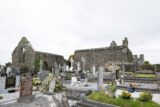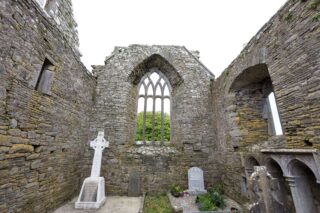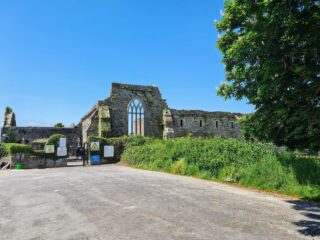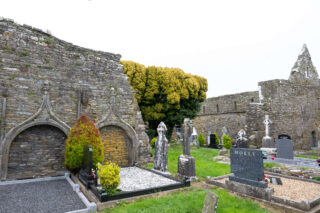Notice
Lislaughtin Abbey is a state-owned National Monument in the care of the Office of Public Works
WARNING: It should be noted that these sites are unguided and a level of care and caution should be maintained during all stages of your visit. The Office Of Public Works (OPW) will not be held responsible for any damages, injuries, or losses that occur
Lislaughtin Franciscan Abbey
Lislaughtin Abbey is a Franciscan friary, just over 1km from Ballylongford, in the diocese of Ardfert and Aghadoe. It was built by John O’Connor Kerry, Lord of Kerry, in 1470 on possibly an earlier church dedicated to St Lachtín who died in 622 AD. In May 1477, the Franciscan pope, Pope Sixtus IV gave licence to O’Connor Kerry to house the friars. The abbey was in turn the eternal resting place for John O’Connor Kerry in 1485 and his kinsmen, as well as Thomas Fitzgerald, heir of the Knight of the Glin, executed in 1567. After John O’Connor Kerry abdicated his position in favour of his son and heir, Cornelius, John and his wife Margaret Nagle retired to the friary. Cornelius O’Connor Kerry, had a silver processional cross commissioned in 1479 and is held in the National Museum of Ireland – Archaeology. The gothic inscription reads: “Cornelius son of John O’Connor, head of his sept and Eibhlm, daughter of the Knight, caused me to be made at the hands of William O’Connor, A.D. 1479.”
Nearby, Carrigafoyle Castle, was built by Conor Liath O’Connor Kerry (John’s son), in the late 1490’s. The castle is on a piece of land off the Shannon estuary and was known as the guardian of the Shannon. The castle was typical of an Irish tower house but its strategic location meant command of the shipping routes that traders used to supply Limerick. This castle was attacked during the second Desmond Rebellion in 1580. Sir William Pelham, in the company of Sir George Carew, bombarded the castle for two days with demi-canons and a culverin. The Earl of Ormond noted that the castle became slippery with blood. The castle capitulated, as did many other Desmond supporting strongholds.
It was after the siege of Carrigafoyle Castle in 1580, that Lislaughtin Abbey was attacked. This attack was a fallout of the failed second Desmond Rebellion and resulted in the murders of friars Fathers Donatus O’Hanrahan, Philip O’Shea and Maurice O’Scallan before the high altar.
It wasn’t until 1629 that some friars returned, but it was attacked and sacked again, during the Cromwellian campaign in 1652. The silver processional cross, commissioned in 1479, was buried, possibly by the friars, and was only discovered in March 1871 by accident when a local farmer was out ploughing. The friary was abandoned thereafter and granted to various individuals, including James Scolls, Sir Edward Denny and, in 1860, John Tuomy.
Lislaughtin Abbey is a long house divided into a choir and nave. A tower, long since gone, located over the choir was a four storey 60ft tall structure. The choir, between the nave and the sanctuary, was an area for seating the clergy and choir, and was lit by a window in the east wall. This window is divided into four by stone mullions and surmounted by bar tracery. The south wall of the choir has three windows divided in two by stone mullions. All the windows are from cut limestone and all are pointed. Along the south wall of the choir is a tripe sedilia, seating for the clergy, in stone. The north wall of the choir has a doorway that leads to the refectory on the ground floor and dormitory above. This building has 30 windows, and north east of it a two-storey structure housed the friary’s garderobe.
The nave, the central part of the building to accommodate the congregation, has two entry points. On the west gable lies the main entrance. It is formed from cut limestone and is almost 2m high. Over the doorway is a pointed window, originally a twin-lighted window. The second entry point is on south wall, 1.7m tall and of cut limestone. The nave’s interior has two tomb niches with ogee-form hoods and pinnacles in the north wall.
Visit Historic Environment Viewer for more information on Lislaughtin Abbey
Protect our Past - Click here to read about the importance of protecting our country’s unique heritage sites
This national monument is protected in accordance with the National Monuments Acts 1930 to 2014
Gallery
Nearby sites to visit
Scattery Island Monastic Site and Visitor Centre
Discover the History, Myth and Legend of Scattery Island
Approx. 7.0 km from Lislaughtin Franciscan Abbey
Listowel Castle
The last bastion of the Fitzmaurices
Approx. 12.6 km from Lislaughtin Franciscan Abbey
Desmond Castle Newcastlewest
Where sounds of medieval revelry echo around the walls
Approx. 30.1 km from Lislaughtin Franciscan Abbey
Ardfert Cathedral
A trio of medieval churches devoted to St Brendan
Approx. 33.1 km from Lislaughtin Franciscan Abbey
Askeaton Castle
A ruined stronghold of the earls of Desmond
Approx. 33.8 km from Lislaughtin Franciscan Abbey
Adare Castle
Discover a medieval masterpiece, built for defence
Approx. 46.0 km from Lislaughtin Franciscan Abbey




